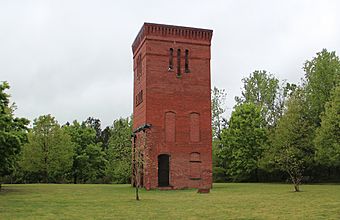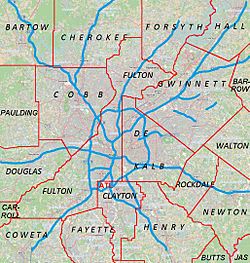Whittier Mill Village facts for kids
Quick facts for kids |
|
|
Whittier Mills Historic District
|
|

Whittier Mill Park
|
|
| Location | Roughly the jct. of Bolton Rd. and Parrot Ave., approx. 7 mi. NW of central business district of Atlanta, Georgia |
|---|---|
| Area | 30 acres (12 ha) |
| Architect | Parsons and Wait |
| Architectural style | Bungalow/Craftsman, Colonial Revival |
| NRHP reference No. | 01000972 |
| Added to NRHP | September 13, 2001 |
Whittier Mill Village, originally called Chattahoochee, is a special neighborhood in Atlanta, Georgia. It's found on the Upper Westside of the city. This area is famous for its old mill and the homes built around it. It's so important that it's listed as the Whittier Mills Historic District on both local and national lists of historic places. The mill and the village were started in 1895. This place is a great example of how a mill and its village worked together in the Southern United States. Today, only parts of the old mill are left. However, most of the original houses are still standing.
Contents
What is Whittier Mill Village?
Whittier Mill Village was once a busy place where people lived and worked. It was built around a large textile mill. Textile mills made cloth from cotton. This type of community, where a factory builds homes for its workers, is called a "company town" or "mill village." It was common in the Southern United States many years ago.
A Look Back: How the Mill Started
The Whittier Mill was founded in 1895. It was built by a company that wanted to make cotton into yarn and fabric. The mill was named after a famous poet, John Greenleaf Whittier. The company also built houses nearby for the people who worked at the mill. This made it easy for workers to live close to their jobs.
Life in the Mill Village
Life in a mill village like Whittier was very connected to the factory. The mill provided jobs for many families. It also often provided other things, like a store or a school. The mill owners wanted to create a stable community for their workers.
Homes and Community
The houses in Whittier Mill Village were built in popular styles of the time. These included Bungalow/Craftsman and Colonial Revival designs. These homes were often simple but comfortable. They were built close together, which helped create a strong sense of community among the mill workers and their families. People lived, worked, and socialized all within the village.
What Remains Today?
Today, the Whittier Mill no longer operates. Only some ruins of the old mill buildings are left. These ruins are now part of a park, Whittier Mill Park. It's a place where people can visit and learn about the area's history. Even though the mill is gone, many of the original houses in the village are still there. They remind us of what life was like over a hundred years ago.
Protecting History: The Historic District
Because of its unique history and surviving buildings, Whittier Mill Village was recognized as a historic district in 2001. A historic district is an area with a group of buildings or sites that are important to history. When an area becomes a historic district, it means people want to protect its special character. In 2001, the Whittier Mills Historic District included 98 buildings that helped tell its story. These are called "contributing buildings." It also had one important structure and one important site. There were also 16 buildings that were newer and didn't contribute to the historic feel.


